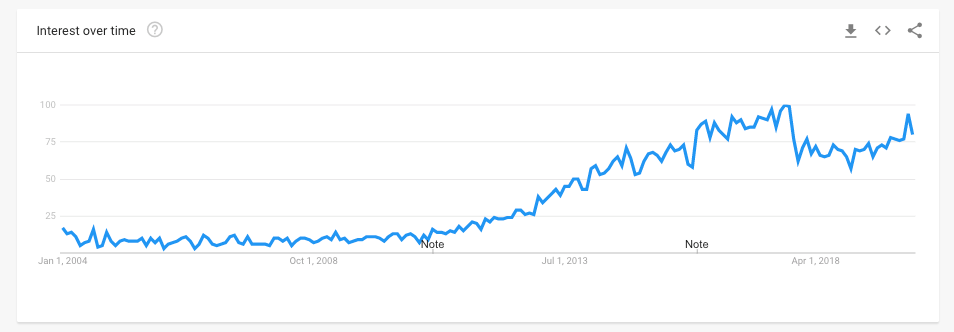Content marketing has, undeniably, grown dramatically in popularity over the last decade.
With that has come confusion about what it is and what the goals of it are.

When I started in SEO and digital marketing in 2009, there was no concept of “content marketing”.
Companies still weren’t convinced they could make money with a web presence.
Technology hadn’t progressed nearly as far as it has current day, so algorithms and systems used to rank websites were still fairly rudimentary.
They were also pretty easy to game.
SEO at that time was trying to keep one step ahead of the search engines.
You’d do things that worked, someone would blog about it, it would get saturated and stop working (this still happens today), and then people would move to the next tactic of the day.
And content marketing?
Yeah right.
Some companies were blogging – and those that were often were winning in their specific verticals because they had realized what others hadn’t and what many still don’t today:
That building goodwill with customers and potential customers via content is one of the best ways to market your business online.
Then came 2012 when a Penguin wandered in from Mountain View and the digital marketing world began to shift under our feet.
Whole industries and large companies fell in seemingly one fell swoop, though if you know any SEO history you’ll know that this actually occurred over 20+ iterations on the Penguin algorithm, which was meant to target things like manipulative link building through paid links and more.
While these tactics and strategies have never gone away, what we have seen is changes in the industry because of this.
One of the big changes relevant to our discussion here today is that many old “link building” firms have become “content marketing” firms.
Thus we end up today with a lot of content marketing firms who are still pretty much blogging shops with a link building bent. They create content to build links to drive SEO.
But is that really marketing?
Or this still just cranking out content to try to manipulate the link graph to then rank in the search engines?
My experience tells me it’s probably more of the second.
All of that said, what does it mean to engage in marketing through content?
And how do we as digital marketers stop looking to just use content to drive links to drive rankings, and instead use content to build businesses holistically?
Well, there are four main areas:
- Content must drive leads and map to business metrics.
- Content must be promoted.
- Content must work across the marketing funnel.
- Content can drive SEO, too.
Here’s how I see it working.
Content Must Drive Leads & Map Back to Metrics That Drive the Business
I once spoke with a B2B (non-marketing) service business entrepreneur who had been working with a content firm for a number of months.
When I asked him about the results he has seen for his business, he kept talking about the number of posts published and their word counts and traffic they had seen from it.
When I asked him how many potential client leads he had gotten from that content and how much revenue those leads had driven for his business, he went quiet.
He couldn’t answer if he was getting a return on that content investment.
Content that doesn’t drive leads or customers is just that – content.
Any editorial content (blog posts, guides, etc) that is meant to be used for marketing must have a purpose behind it and a way for potential clients to learn more.
One of the easiest ways to do this is to go to your Google Analytics and find your top 5 pieces of content by traffic driven.
Then audit each piece to see if you have a relevant piece of content merchandised as an upsell for the visitor to go deeper.
If you don’t have these, then create them (I recommend Dan Martell’s lead magnet approach) (disclosure: Dan is one of my business coaches) and use your favorite form builder to put a download form on your post.
Content Must Be Promoted
Content marketing without promotion is just content.
For content to drive meaningful results in a reasonable period of time, it must be promoted via other means than just search engines.
Content created just for the purposes of attracting links is better than content without even that goal in mind, but attracting links is just one of the many benefits of promotion.
Content can be promoted:
- To your email list of subscribers (who you gathered with your lead magnets) because it solves some pain points they might be feeling. If you don’t want to promote the content to your list, should you have created the content in the first place?
- Via organic social. Many marketers I know use a social media scheduling tool to post the same content multiple times or to spread it across various social platforms.
- Via paid social. There are lightweight and cheap ways to do this (boosting a post on Facebook or using Twitter’s auto-promoted tweets), but the real results will likely come through better-targeted ads on platforms like Facebook and Instagram. Bonus points for promoting middle and bottom of funnel content to retargeting audiences and lookalikes of those.
- In any webinars, presentations, or other places you are creating content that has an audience.
- In email drip campaigns to existing leads who need more education along their journey before they are ready to buy.
Content Must Work Across the Funnel
We must be careful to not collapse our vision of what content can be.
While tempting to collapse “content marketing” into words published on a blog because this is easy to sell to clients and has the highest search volume, we do our clients and ourselves a disservice with this approach.
Why?
Because content is amazing across the whole marketing funnel!
Let’s imagine that your client is a plumber, and they (as well as you) take the approach that the best way to get a customer is to teach the customer what you already know.
The idea is that they’ll realize how challenging it is to do what you’ve spent years honing, so they’ll just contact you instead and want to pay you to solve that problem for them.
In order to create the best content for this plumber client, you must understand their ideal customer’s demographics and the pains that they are facing.
Top of the funnel, you can write (or shoot video!) content for questions like “how to fix a leaky toilet” with a lead magnet that sends them a PDF of in-depth steps on how to fix a toilet.
Be sure to have them give you relevant information you need to qualify them as a potential customer (for a plumber, this is probably the lead’s ZIP code).
For middle of the funnel, you can write content for questions that are more relevant to a plumber’s job like “what tools are required to fix a leaky toilet” that also has the lead magnet for in-depth steps to fix their toilet.
And at the bottom of the funnel, you can target questions about hiring a plumber like “how much does it cost to hire a plumber to fix a leaky toilet”. This page would have a direct CTA to contact the plumber about their services.
See what we’ve done now?
We’ve created content that can rank because it’s complete.
We’ve also created content that can drive leads because you created a relevant lead magnet and merchandised it on the pages.
We’ve built in qualification by ZIP code so you don’t waste time following up with unqualified downloaders.
And you’ve built content that captures people at the various points of their journey to hiring a plumber – asking how to do it in a general way, asking more specific questions about how to fix a toilet, and then finally asking how much it costs to have a professional do it because it’s so much work for them.
Content Drives SEO Too
Finally, let’s not forget about the power of SEO.
A recent study confirms what I have noticed on Credo and what others have mentioned to me – that simply publishing editorial content about a topic that is semantically related to a conversion-oriented page on your site can lift the rankings of those conversion-oriented pages.
One example from my own work on Credo is when we published a guide to SaaS SEO in April 2018.
This guide only has (according to Moz) 10 linking root domains, but it ranks for close to 100 keywords itself with metrics dramatically improving for SaaS-related pages in the next couple of months without focused link building happening:

After technical fixes, content is one of the most effective ways to move the needle on SEO rankings because of its ability to both add contextual relevance (which search engines and users love) as well as its ability to attract meaningful links.
When you look past content for the sake of content or content as just blog posts, and instead expand to content that maps across the buyer’s journey and can be used for SEO on transactional pages as well, the whole world of content marketing opens up and we’re able to see dramatic results.
Let’s Put the ‘Marketing’ Back in ‘Content Marketing’
I hope I’ve convinced you that content without a promotion strategy or strategy to drive leads is simply content.
In order to truly do content marketing, it must get results through a promotion strategy to both new and old customers as well as taking into account their journey and how content can affect other channels as well.
Let’s commit this year to making sure we’re doing great marketing alongside great content.
More Resources:
- Content Marketing: The 5 Most Important Things You Need to Know
- How to Make Content Marketing Part of Your Company’s DNA
- 7 Steps to Drive More Conversions with a User-Focused Content Matrix
Image Credits
Featured Image: Created by author, February 2020
All screenshots taken by author, February 2020





